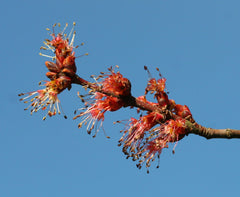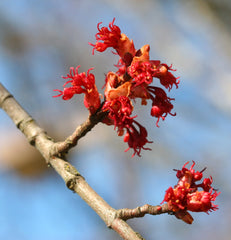The nesting boxes for the plant kingdom are a classic Montessori material. (They are usually called Chinese boxes, but I don’t like to use that term. They certainly didn’t come from China.) Like many other materials that were created many years ago, this one needs a make-over or at least a reality check to see if it reflects what children will see in their later studies.
Paraphrasing a Chinese proverb, if your nesting/Chinese boxes are based on a two-kingdom classification, and they contain the bacteria and fungi, the best time to change them was before 1980. The second best time is now.
The point of elementary studies isn’t to teach children names and ideas that they are not likely to see again. Maria Montessori said that children who complete her elementary program would have acquired knowledge equal to a high school student of her day. She wasn’t trying to create a separate set of biology terms; she was giving children the mainstream academic knowledge of her day. Continuing to use the terminology and concepts of the traditional lessons without checking to see current academic view leads to problems. Children may have to discard their Montessori lessons and go back to the beginning to learn contemporary biology. “Unlearning” is very hard for people. They tend to cling to the first way they learned something, and they must accept that their version is wrong before they can accept another view.
If there were nesting boxes that reflect the current academic view of the plant kingdom, how would they look? Here are my ideas.
Picture a large, green box that is labeled “Plant Kingdom.” It could have other labels as well as that main one. Possibilities are the more formal Latin Kingdom Plantae, or the more descriptive one, Embryophytes. The latter is the informal scientific name for land plants.
We take the lid off this box and find a small box labeled “Bryophytes, the nonvascular plants” and a much larger one labeled “Tracheophytes, the vascular plants.” Inside the bryophyte box, there are three smaller boxes labeled “hornworts”, “liverworts”, and “mosses.” Should there be a label for the division/phylum of these boxes? There doesn’t have to be. I have an advanced botany textbook that doesn’t use a Linnaean rank name for these branches of plant life. If you want to add the division/phylum names, see Wikipedia. It is generally quite good for plant classification.

The larger Tracheophyte box contains two boxes, a small one labeled “lycophytes” and a much larger one labeled “euphyllophytes, the true-leaf plants.” The lycophyte box has three small boxes inside, the club mosses, spike mosses, and quillworts. Alternatively, the lycophyte box could list these three lineages on the lid and not separate them. They are best described as orders of the lycophytes.

The euphyllophyte box has two boxes inside, a smaller one labeled “fern clade, the monilophytes” and a larger one labeled “Spermatophytes, the seed plants.” The fern clade box has several smaller boxes. They are labeled: “ophioglossids – whiskferns, alder’s tongue ferns, and grape ferns”; “equisetums – the horsetails and scouring rushes”; and “leptosporangiate ferns or polypod ferns – the true ferns.” If your school is in a tropical climate, you may need to add a fourth box for the marattid ferns. They are huge plants that grow only in the tropics.

The spermatophyte box holds two boxes, the angiosperms or flowering plants, and the gymnosperms, the naked seed plants. The gymnosperm box holds four boxes – the cycads, the ginkgo, the conifers, and the gnetophytes. It is uncertain at present whether the gnetophytes belong in their own separate box or within another of the seed plant boxes. It is clear that they do not belong in the angiosperm box, however.
The angiosperms or flowering plants must have a big box. They make up about 90% of the plant kingdom. There are several boxes inside their box. A couple of very small boxes hold the first branches – the water lilies and the anise tree. Then there is a small box labeled “magnoliids,” a medium box labeled “monocots,” and a large box labeled “eudicots.” Three-quarters of the flowering plants are eudicots; about 22% are monocots.
All this can be imagined, but it will take quite some creativity to make physical containers that can actually hold an image and information about each of these branches of the plant kingdom. The information should include the lineages of the plant. For example: Sunflower lineages – embryophytes, tracheophytes, euphyllophytes, spermatophytes, angiosperms, eudicots. The text should also give some of the defining features – the derived traits – of each group.
If you need the illustrations or more information, see https://big-picture-science.myshopify.com/collections/montessori-botany-materials/products/the-plant-kingdom. This is a pdf of a PowerPoint for teacher education. You can print the images for use in your classroom. It has all the images you need except quillworts. Those lycophytes are rare, and the main reason to include them is that they are the closest relatives to the ancient Lepidodendron trees.
Please let me know if you need help or have questions on plant kingdom nesting boxes. If you want to have another set for the flowering plants, that’s a more involved story. It would be fun to do, however.
Happy plant explorations,
Priscilla
Many people are surprised to learn that broadleaf trees are flowering plants. It is true that most of them do not have the showy blossoms that people associate with the word “flower.” Members of the rose and magnolia families aren’t subtle with their flowers. Any sighted person can tell they are blooming.
Other kinds of trees may have quite inconspicuous flowers. The blooms may be so subtle that most people, including children, do not notice them. Help your children see these structures as they happen briefly in spring.
The red maples are among the first to bloom. Maples have a variety of flower structures and reproductive strategies. Some have yellow-green flower clusters that have both staminate and pistillate flowers. Others make extra staminate flowers and only a few with pistils.
Red maples are mostly dioecious – they have staminate and pistillate flowers on separate trees. I say “mostly” because I have seen and read other reports that a tree of one sex will sometimes have one branch that has the opposite sex flowers. This probably helps insure that pistillate flowers will receive the pollen they need to make seeds.
When the red maple starts to bloom, you may notice a red tint on the branch tips. If you can find a branch that is low enough for you to examine (try binoculars if the branches are too high), you will find one of two types of flowers. Neither has petals; both are small. The pistillate flowers (left) have two-branched stigmas showing. They are more intensely red than the staminate flowers (right), which look like a tiny pom-pom in reddish pink.

After the flowers bloom, the staminate flowers fall off. They have released their pollen, and their work is done. The pistillate flowers that received pollen continue to grow, and they develop long stalks with their young fruits at the end, often still bearing the drying stigmas. The fruits will become the maple keys; two grow joined together, but they split at maturity. This makes a maple fruit a schizocarp. Its two sections are samaras, winged fruits that the wind disperses.
Elms are another family of early bloomers. Their flowers are tiny, just two little furry stigmas surrounded by stamens. The developing fruits – again they are samaras – often color the tree a spring green and then turn brown before the leaves are completely unfurle d.
d.
Ask your children to think about the adaptation of blooming early, having wind-pollinated flowers, and having wind-dispersed fruits. They may be able to reason that the trees must bloom early so that their leaves won’t interfere with the pollen transfer. Some trees, like the elms, even disperse their seeds before the leaves block the wind from the mature fruits.
Swelling buds and developing leaves and shoots make great subjects for botany observation. Enjoy them with your children as the shoots and the spring develop.
Priscilla, April 9, 2018
I have two new posters that do a good job showing the history and diversity of life. The first is just out from Fairhope Graphics, and it is called “A History of Existing Angiosperms.” The many branches of flowering plants show up very well on this poster. You can see why there’s more to flowering plant lineages than monocots and dicots. The timescale on the left of this poster could lead to confusion, so you will need to explain to your children that all the pictures show flowering plants that still exist. Each illustration is placed at the time when we think its lineage originated.

An important qualifier for this information – plant fossils are so much harder to find than large vertebrate fossils. Paleobotanists have to piece the story together from small, hard-to-preserve fragments, not large bones, so it could well be that a number of these plants will have a different age of origin as scientists obtain more fossil data. That should not detract from the information show here, however.
You can see from this poster that the plants had developed their major lineages before the K-Pg (K-T) extinction, and these lineages survived much better than the large vertebrates. The poster has the number of species and the common names of a few members for each lineage.
Look for the three main branches of angiosperms, the magnoliids, the monocots, and the eudicots, on the poster. You can also find two large branches of the eudicots, the rosids and the asterids. The rosids split into the fabids and the malvids. The asterid subdivisions are the lamiids and campanulids. These seem like a bunch of big meaningless names until you put a flower image with them, so this Fairhope Graphics poster will help make the lineages more memorable.
Fairhope Graphics also has useful posters on the lineages of birds, the Tree of Life at a simple and more advanced level, and the history of the Earth.
My second recently acquired poster is from a company called Evogeneao, which they explain on their website is short for evolutionary genealogy. The motto of this organization is “Life on Earth is one big extended family.” Their “Evolution Cousin” poster shows their branching diagram for all of life, along with several familiar organisms and a number that reflects their relationship to us. For instance, your cat is your 27 millionth cousin. You can also get a larger poster that features the Tree of Life as the main graphic and gives information about it. These posters would be great for an impressionistic lesson on the Tree of Life. If you decide to use one of these posters in your classroom (or even if you do not) you will find it useful to read the Tree of Life page under the “Learn” menu on the Evogeneao website.

Under the “Explore” menu there, you can select “Tree of Life Explorer.” When you can click on an organism, you will see lines appear from humans and the selected organism. These lines meet at the most recent common ancestor. It is a very cool illustration of our relation to all of life.









 d.
d.

